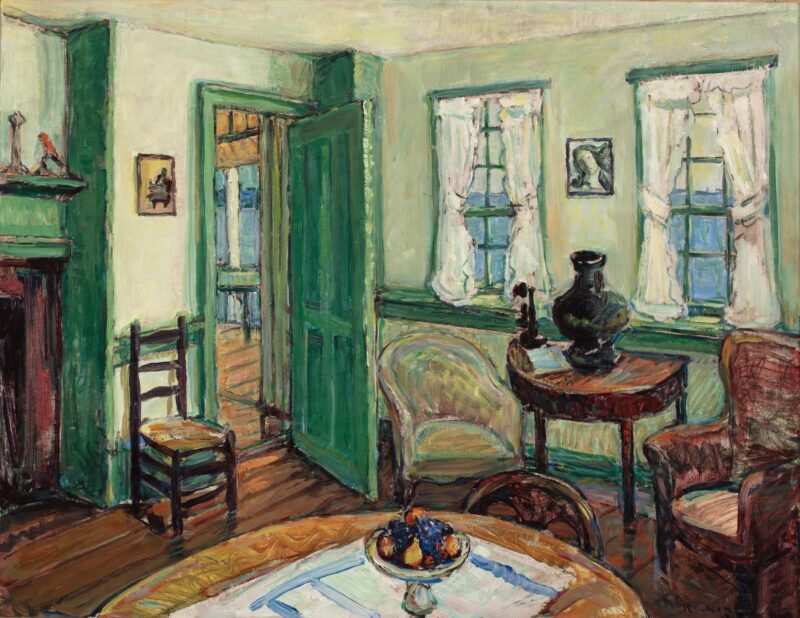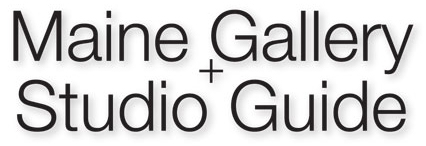
These are the final weeks to experience the Ogunquit Museum of American Art’s 2024 exhibitions. These shows are on view through Nov. 17.
Lee Krasner: Geometries of Expression
This focused exhibition sheds light on the often-overlooked early career of Lee Krasner (1908–1984) and places her work within the context of her peers. In the 1930s and early 1940s, Krasner rose to prominence as a dynamic voice within the vanguard circles of contemporary artists living and working in New York City. During a period, fraught with socio-economic turmoil and political upheaval, the artist was politically active, taking part in the lively debates at the Artists Union as well as protesting the Museum of Modern Art. Her network was also far-reaching and animating. She forged relationships with artists within the orbit of European emigres like Piet Mondrian and Hans Hofmann and those who formed organizations such as the American Abstract Artists Group. Geometries of Expression explores how this rich exposure to politics and people shaped Krasner’s experimentations with geometric abstraction. The show consists of approximately 45 works, with notable examples by Krasner.
Domestic Modernism: Russell Cheney and Mid-Century American Painting
This exhibition examines the artist Russell Cheney (1881–1945) and his relationship with his partner, the influential literary historian and critic F.O. Matthiessen (1902–1950). It seeks to marshal the term “domestic” to reframe and reassert Cheney’s work within modernism in the United States at mid-century. First, the word suggests a focus on small-scale, figurative modern art — the kind produced by Cheney — that has been generally undervalued and understudied since it was overshadowed by the large-scale, gestural non-figuration of Abstract Expressionism. Second, “domestic” here also recognizes the importance of the local setting for Cheney’s production, which was the house in Kittery Point, Maine, which he shared with Matthiessen. By placing Cheney’s work in this domestic context, the exhibition and its catalog will contribute to a more expansive — and at the same time, more inclusive—view of mid-20th-century American modernism and will demonstrate the diversity of practices at the time. This exhibition is produced in collaboration with Vanderbilt University.
Networks of Modernism, 1898–1968
The Ogunquit Museum of American Art (OMAA) is pleased to offer viewers new ways of seeing the permanent collection in Networks of Modernism. Drawing primarily from OMAA’s permanent collection, this exhibition maps the ways artists responded to the immense social, political, and economic changes affecting life in the United States over 70 years: from 1898 — the founding of Charles Woodbury’s school in Ogunquit — to 1968. During this time, Ogunquit emerged as an important hub within a vast network of progressive art schools and communities that connected modern artists across the United States and abroad. Organized into a series of thematic groupings, Networks of Modernism contextualizes the artists who lived, worked, or frequented Ogunquit within a broader story of American modernism. Alongside well-known examples from OMAA’s holdings, the exhibition presents several works on view for the first time.
The Sea, Just Like Your Eyes, Became a Refuge: A Joe Wardwell Mural Commission
Joe Wardwell (b. 1972) is a Boston-based painter and muralist. His work reflects on the traditions of landscape painting, literature and popular music in the United States and delves into their interconnected role in defining the ideas and values of “Americanness.” The Sea, Just Like Your Eyes, Became a Refuge reflects on the powerful, yet fragile, point where sea and land meet. For this site-specific, exterior mural — the first for OMAA, and first since 2013 for the artist—Wardwell selected passages from Notes from the Sea (2024, White Pine Press)—a work by Chilean American author, human rights activist, and Ogunquit resident, Marjorie Agosín. The murals activate OMAA’s iconic modernist building and ask visitors to reflect on the churning of nature, culture, memory, and being that occurs at the edge of the ocean.
The Architect of a Museum
In 1953, Henry Strater in partnership with a group of artists and community members, opened the Museum of Art of Ogunquit (now the Ogunquit Museum of American Art). Reflecting on this milestone, this exhibition dives into the museum’s archives to explore the construction of OMAA’s original 1952 building designed by architect James Worley Jr., as well as the inaugural collection that was acquired for the building’s debut. A selection of the original architectural plans for the museum will be put on view for the first time alongside archival materials documenting the institution’s opening. A group of works gifted by Strater that formed the founding collection of the museum will accompany this display. Together, this exhibition will bring visitors back to the start of a legacy over 70 years strong.
The Ogunquit Museum of American Art is at 543 Shore Road, Ogunquit. Opened in 1953, OMAA was founded by the artist Henry Strater. The museum shares close historic and geographic ties to one of the earliest modern arts communities in the United States. OMAA houses a permanent collection of paintings, sculpture, drawings, prints and photographs from the late 1800s to the present. The museum showcases American art by mounting modern and contemporary exhibitions and accompanying educational programming and events. For more information, visit www.ogunquitmuseum.org.
Categories: exhibitions, gallery, Ogunquit, shows

